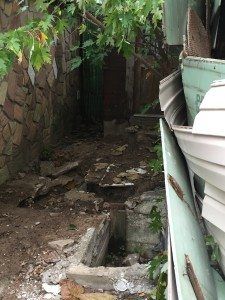Life In Sheepshead Bay’s Bungalow Courts Is Still Rotten Three Years After Sandy

By Hayley Lind
Residents of a vulnerable stretch of Sheepshead Bay devastated by Superstorm Sandy say they’re still waiting for help after more than three years of empty promises.
According to the city’s Office of Housing Recovery, most Sheepshead Bay residents have received their reimbursement checks and repairs have started on more than half of the neighborhood’s damaged homes. Mayor de Blasio also recently announced that all building affected by the storm would be repaired by the end of next year.
Still, the folks who live in the bungalow community between Brown and Batchelder streets have yet to see much progress. They contend Build it Back, the city entity that sets up homeowners with contractors, is far behind on its work.
“They’re just getting the measurements of our house now,” said Jennifer Fridstrom, a 36-year-old teacher whose home on Stanton Street, between Brown and Batchelder, was heavily damaged by Sandy. “They haven’t done any design plans yet.”
Sam Breidbart, a spokesman for Build it Back, said the structures in the bungalow community known as the “courts” are considered “some of the most vulnerable homes” in the neighborhood.
He did not directly address why it is taking so long to get repairs started, other than to say, “we aren’t so far away from” the design consultations needed to begin the process.
Constructed five feet below street level, the courts operate on private sewage systems – complicating repairs to homes that suffered major flood damage.
Fridstrom said she has received conflicting information about the future of her home. She was told in one letter that her home would be elevated. Another informed her house would be rebuilt.
“Why would you repair my house if you are going to replace it?” she asked.
Fridstrom is among residents who say they’ve run out of patience with Build it Back.
They point to abandoned homes that mar the area. In addition to dodging falling pieces of buildings, locals say they must avoid nasty smells, disease-ridden bugs, mold and the sewage puddles that constantly cover the walkways.
Fridstrom’s dog was recently diagnosed with mold allergies, which she believes is related to the abandoned house at nearby 2811 Brown Street.

There is old furniture and mold in the basement of the vacant home. The roof is decaying and the back of the house has fallen off, creating a ditch in the backyard.
Fridstrom predicted that it is only a matter of time before the residents feel the health effects, too.
“If it’s affecting her, then it’s affecting us as well, we just don’t realize it yet,” Fridstrom said.
Meanwhile, the vacant property on 31 Stanton Street is about ready to cave in.
“If it collapses, it’s going to knock this house down and that house is going to knock my house down,” said Jo-Anne Niemczyk, a retiree who lives on Stanton Street.
Mike Rodriguez, a retired school crossing guard who lives at 30 Stanton Street, said the owner of the abandoned neighboring home has not been seen for years.
“He’s not gonna make any efforts,” Rodriguez said.
Breidbart explained that the repair process for the abandoned houses is complicated. The homeowners, who left after Sandy, never registered with Build it Back, so they are not eligible to receive the funding available to Fridstrom and her neighbors, he said.
Breidbart added that residents who registered with Build it Back in 2013, should receive their design consultations soon. Then Build it Back will determine whether a house should be replaced or elevated on a case-by-case basis.
Fridstrom and her neighbors, meanwhile, still have to weather unsafe and unsanitary conditions for another year.
“I am angry that it is taking this long for Build it Back to get things going,” said Fridstrom. “It’s frustrating to live in places like this and be concerned for your health.”



